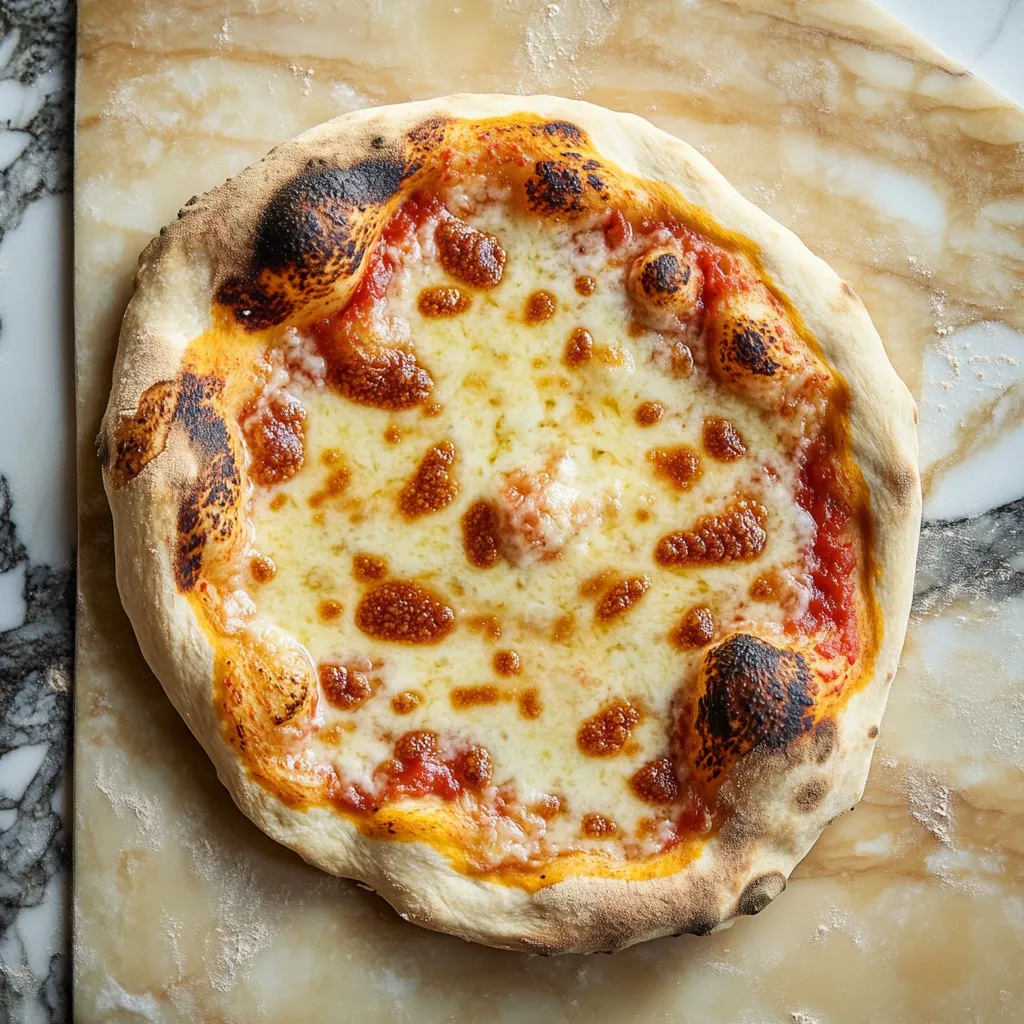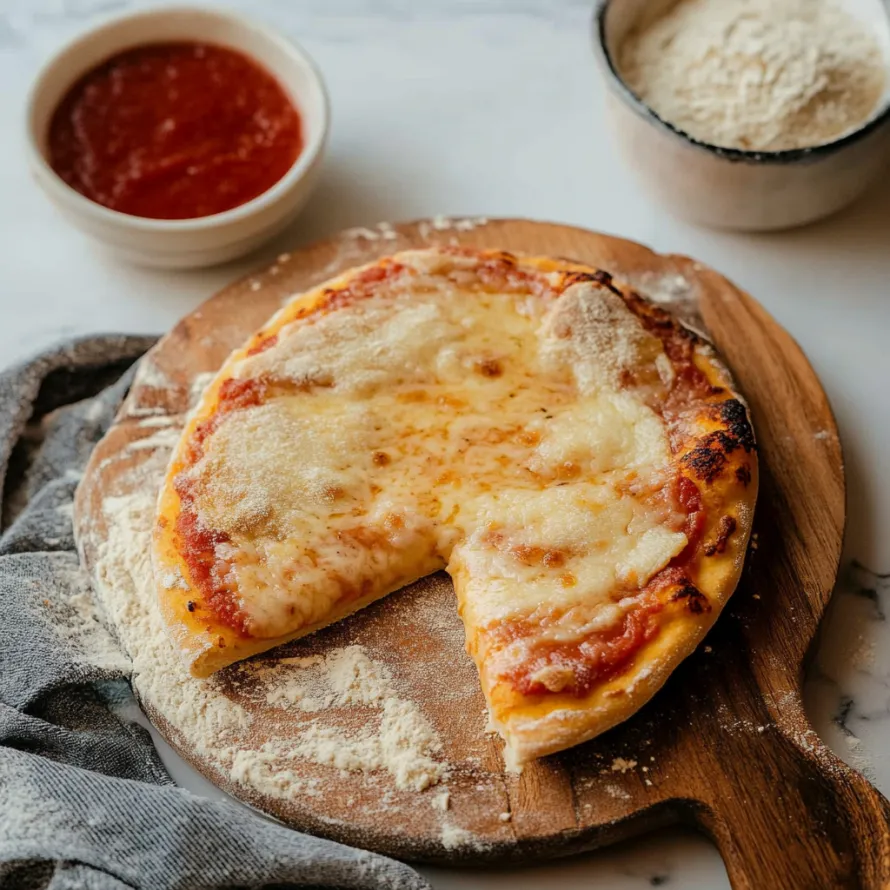 Pin
Pin
Making this tangy sourdough pizza base turns regular homemade pizza into something truly special, delivering that distinctive sour taste and the perfect mix of chewy inside with crispy outside that only sourdough creates. I've spent tons of time getting this method just right, and now I wanna share how you can make real Neapolitan-style pizza in your kitchen without any fancy equipment.
I came up with this method during lockdown when we couldn't go to our usual pizza place. After trying loads of different versions, my family now begs for this pizza every Friday, and my friends always ask me how I make my sourdough pizza so good.
What You'll Need
- 500 grams type 00 flour: Gives you that real Italian feel and fantastic gluten structure
- 340 grams water: Makes the dough just wet enough to stretch well but still handle easily
- 75 grams levain: Does the rising work naturally while adding that wonderful sour taste
- 12 grams salt: Boosts all the tastes and makes the dough structure stronger
- San Marzano tomatoes: Give a sweet clean taste without being too acidic for your sauce
- Good quality olive oil: Adds a nice richness and helps keep your base from getting soggy
How To Make It
- Get Your Levain Going:
- Mix 30g starter with 30g flour and 30g water. Keep it covered around 78°F for 3-4 hours until it's bubbly. You'll know it's ready when it looks puffy and smells slightly sweet and sour. This bit sets up how your dough will taste and rise.
- Put The Dough Together:
- Add levain, water, salt and flour in a bowl. Stir until rough, then use wet hands to fold it over itself for about 30-60 seconds until it comes together. It should feel a bit sticky but not wet. Getting this right now means better fermentation later.
- Let It Rise First Time:
- Cover the bowl and let the dough sit for 3-4 hours at 78-80°F. It won't double in size but will expand a bit. During this time, it builds flavor and strength as good acids form. Look for tiny bubbles throughout the dough.
- Make Your Dough Balls:
- Put a little oil in a 9×13 pan. Cut dough into 6 pieces about 150g each. Shape each into a tight ball by pulling edges together and pinching, then roll under your curved hand to create tension on top. Be gentle so you don't pop the bubbles. Each ball should look smooth.
- Let Them Rise Again:
- Cover your shaped balls and let them sit about 3 hours at 78°F. The balls will get bigger and feel soft and pillowy. This part is super important for getting the right texture inside your final crust.
- Get Ready To Bake:
- Put your rack at the highest spot near the broiler. Place a pizza stone, steel or upside-down baking sheet on the rack. Heat to 550°F for 30 minutes. Get a pizza peel or board ready with some semolina flour. This high heat works like traditional pizza ovens.
- Shape And Add Toppings:
- Gently push dough from the middle outward with your fingertips, keeping the edge puffy. Stretch by turning it on your knuckles until it's about 8 inches across. Add your blended tomato sauce, fresh mozzarella and whatever toppings you like.

That 00 flour really is the magic ingredient here. When I first changed from regular flour to 00 flour, my family spotted the difference in texture and taste right away. My daughter actually jumped up and down after taking her first bite of the better version.
Preparing In Advance
This dough gets even better when it sits in the fridge. After you've shaped your balls, you can stick them in the refrigerator for 2-3 days. The slow cold fermentation creates deeper flavors while the acids make the gluten stronger. When you're ready to cook, just take them out of the fridge about 1-2 hours before shaping so they can warm up a bit.
Getting Your Stretch Right
The trick to real Neapolitan pizza is keeping that fluffy outer edge while making the middle nice and thin. When you stretch your dough, only press on the middle part, working your way out but stopping about an inch from the edge. Don't ever use a rolling pin - it'll crush all those lovely air bubbles. If the dough fights back when stretching, just leave it alone for 5 minutes and try again. Being patient gives you perfect pizza.
Working With Sourdough Timing
Sourdough works differently depending on how warm your kitchen is. In hot kitchens over 80°F, your dough might be ready faster. In cooler places under 75°F, it'll take longer to rise. Look for signs rather than watching the clock. The dough should look puffy with little bubbles all through it, and feel light and a bit tacky. Trust what you see and feel more than your timer.

There's something really special about making awesome pizza at home - grab a piece and dig in!
Recipe Q&A
- → Can I use regular flour instead of type 00?
Sure, bread flour works fine if you can't find type 00. But when using King Arthur 00 specifically, you'll need to add about 50-60 more grams while mixing since it doesn't have as much protein.
- → How long can I keep the dough in the fridge?
You can chill the shaped balls for 48-72 hours, and this cold time actually makes them taste better. If you need longer storage, freeze them for up to a week or partially bake the crusts.
- → What if I don't have a sourdough starter?
For a quicker option without starter, just add ¼ teaspoon of instant yeast to the mix. Let it sit for 2 hours, form your balls, then leave them out for 3-4 hours or pop in the fridge for up to 2 days.
- → Why does my dough stick to the peel?
You'll want to sprinkle plenty of semolina or cornmeal on your pizza peel. This creates little gaps so the pizza can slide off. Always give the peel a little shake before you put it in the oven to make sure the pizza moves freely.
- → How do I get a really crispy crust?
Heat your oven with a pizza stone or steel as hot as it goes (500-550°F) for at least half an hour. Put your rack near the top and turn on the broiler at the beginning to get that nice char on your crust.
- → Can I make the sauce days before?
You bet! The basic Italian sauce keeps well in the fridge for several days. The oil in it helps it stay fresh and adds richness that keeps your pizza from getting soggy.
